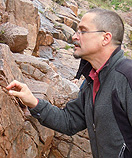News
Better assessment of ash cloud hazards
goal of UB volcanologist’s research
-
 Print
Print -
 Comments
Comments
-

Marcus Bursik’s research is helping to improve the international community’s ability to assess hazards from volcanic ash clouds.
A UB volcanologist who is an expert in volcanic ash clouds and their impact on air travel is in Iceland this week attending two major meetings on last spring’s eruption at Eyjafjallajökull, which spewed a volcanic ash cloud that halted air traffic throughout Europe for days.
Marcus Bursik, professor and chair of the Department of Geology, is a recent recipient of a National Science Foundation (NSF) RAPID Response Research grant to address some of the aviation issues posed by volcanic plumes. He also is principal investigator on an NSF grant to study “Particle Trajectories in Volcanic Plumes: Tracking the 2010 Eyjafjallajökull Plume.”
“The purpose of our research is to help improve the international community’s ability to assess ash cloud hazards,” explains Bursik, who also will tour Eyjafjallajökull while in Iceland. “Our research could have important ramifications for air traffic over the next several years and has the potential to result in important savings to industry by developing tools that will make possible more precise assessments of the hazards of ash clouds.”
He notes that historic eruptions at the Eyjafjallajökull volcano have lasted for a year or more and triggered eruptions at nearby Katla volcano, which in the 18th century produced such dense smog that it destroyed crops and livestock.
“Some of our goals, for example, are better assessment of the particle concentration and trajectories of the ash clouds that will help aviation officials better determine flight routes and no-fly zones during volcanic crises,” he says.
To improve the understanding of all of the uncertain variables that affect the behavior of a volcanic ash cloud plume, such as eruption strength and wind speed, Bursik and his colleagues will employ several modeling techniques, including ensemble forecasting, a statistical prediction method, to develop probabilistic ash cloud maps as well as volcanic ash dispersion models.
“We will use the models to ‘hindcast’ the direction of the ash cloud produced last spring by Eyjafjallajökull, meaning we will run model tests to see whether it can accurately predict the course of that ash cloud,” he explains. “If so, then that gives us confidence that the model can produce the probabilistic estimates of potential ash cloud behavior.”
Co-investigators on the grant include Matthew Jones, deputy director of the Center for Computational Research in UB’s New York State Center of Excellence in Bioinformatics and Life Sciences, and UB faculty members in the departments of Mathematics and Mechanical and Aerospace Engineering. Additional investigators include colleagues at the Geophysical Institute at the University of Alaska, Fairbanks NOAA-NESDIS and Michigan Technological University.
Bursik is a member of the UB Center for GeoHazards Studies, which is supporting the strategic strength in mitigation and response to extreme events identified in the UB 2020 strategic plan for academic, research and service excellence.

Reader Comments